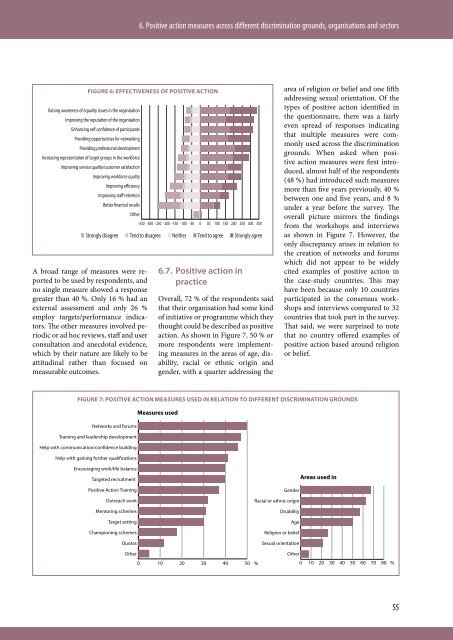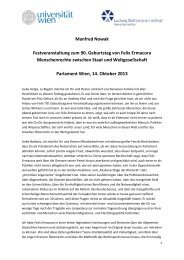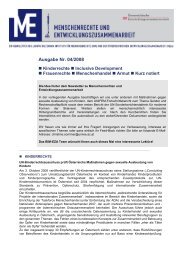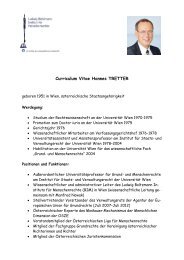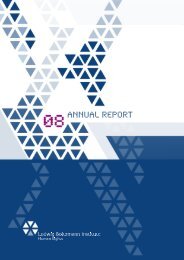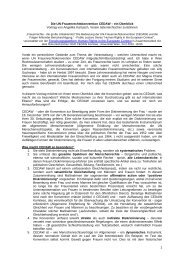International perspectives on positive action measures - European ...
International perspectives on positive action measures - European ...
International perspectives on positive action measures - European ...
Create successful ePaper yourself
Turn your PDF publications into a flip-book with our unique Google optimized e-Paper software.
A broad range of <strong>measures</strong> were reported<br />
to be used by resp<strong>on</strong>dents, and<br />
no single measure showed a resp<strong>on</strong>se<br />
greater than 40 %. Only 16 % had an<br />
external assessment and <strong>on</strong>ly 26 %<br />
employ targets/performance indicators.<br />
The other <strong>measures</strong> involved periodic<br />
or ad hoc reviews, staff and user<br />
c<strong>on</strong>sultati<strong>on</strong> and anecdotal evidence,<br />
which by their nature are likely to be<br />
attitudinal rather than focused <strong>on</strong><br />
measurable outcomes.<br />
6. Positive acti<strong>on</strong> <strong>measures</strong> across different discriminati<strong>on</strong> grounds, organisati<strong>on</strong>s and sectors<br />
FIGURE 6: EFFECTIVENESS OF POSITIVE ACTION<br />
Raising awareness of equality issues in the organisati<strong>on</strong><br />
Improving the reputati<strong>on</strong> of the organisati<strong>on</strong><br />
Enhancing self c<strong>on</strong>�dence of participants<br />
Providing opportunities for networking<br />
Providing professi<strong>on</strong>al development<br />
Increasing representati<strong>on</strong> of target groups in the workforce<br />
Improving service quality/customer satisfacti<strong>on</strong><br />
Improving workforce quality<br />
Improving e�ciency<br />
Improving sta� retenti<strong>on</strong><br />
Better �nancial results<br />
Other<br />
6.7. Positive acti<strong>on</strong> in<br />
practice<br />
Overall, 72 % of the resp<strong>on</strong>dents said<br />
that their organisati<strong>on</strong> had some kind<br />
of initiative or programme which they<br />
thought could be described as <strong>positive</strong><br />
acti<strong>on</strong>. As shown in Figure 7, 50 % or<br />
more resp<strong>on</strong>dents were implementing<br />
<strong>measures</strong> in the areas of age, disability,<br />
racial or ethnic origin and<br />
gender, with a quarter addressing the<br />
area of religi<strong>on</strong> or belief and <strong>on</strong>e fifth<br />
addressing sexual orientati<strong>on</strong>. Of the<br />
types of <strong>positive</strong> acti<strong>on</strong> identified in<br />
the questi<strong>on</strong>naire, there was a fairly<br />
even spread of resp<strong>on</strong>ses indicating<br />
that multiple <strong>measures</strong> were com-<br />
m<strong>on</strong>ly used across the discriminati<strong>on</strong><br />
grounds. When asked when <strong>positive</strong><br />
acti<strong>on</strong> <strong>measures</strong> were first introduced,<br />
almost half of the resp<strong>on</strong>dents<br />
(48 %) had introduced such <strong>measures</strong><br />
more than five years previously, 40 %<br />
between <strong>on</strong>e and five years, and 8 %<br />
under a year before the survey. The<br />
overall picture mirrors the findings<br />
from the workshops and interviews<br />
as shown in Figure 7. However, the<br />
<strong>on</strong>ly discrepancy arises in relati<strong>on</strong> to<br />
the creati<strong>on</strong> of networks and forums<br />
which did not appear to be widely<br />
cited examples of <strong>positive</strong> acti<strong>on</strong> in<br />
the case-study countries. This may<br />
have been because <strong>on</strong>ly 10 countries<br />
participated in the c<strong>on</strong>sensus workshops<br />
and interviews compared to 32<br />
countries that took part in the survey.<br />
That said, we were surprised to note<br />
that no country offered examples of<br />
<strong>positive</strong> acti<strong>on</strong> based around religi<strong>on</strong><br />
or belief.<br />
FIGURE 7: POSITIVE ACTION MEASURES USED IN RELATION TO DIFFERENT DISCRIMINATION GROUNDS<br />
Networks and forums<br />
Training and leadership development<br />
Help with communicati<strong>on</strong>/c<strong>on</strong>�dence building<br />
Help with gaining further quali�cati<strong>on</strong>s<br />
Encouraging work/life balance<br />
Targeted recruitment<br />
Positive Acti<strong>on</strong> Training<br />
Outreach work<br />
Mentoring schemes<br />
Target setting<br />
Champi<strong>on</strong>ing schemes<br />
Quotas<br />
Other<br />
-350 -300 -250 -200 -150 -100 -50 0 50 100 150 200 250 300 350<br />
Str<strong>on</strong>gly disagree Tend to disagree Neither Tend to agree Str<strong>on</strong>gly agree<br />
Measures used<br />
0 10 20 30 40 50<br />
Gender<br />
Racial or ethnic origin<br />
%<br />
Disability<br />
Age<br />
Religi<strong>on</strong> or belief<br />
Sexual orientati<strong>on</strong><br />
Other<br />
Areas used in<br />
0 10 20 30 40 50 60 70 80<br />
%<br />
55


